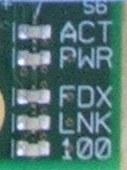Flash the ACT led from the command line, this tip was sent to me so I gave it a try, you could this in a script. The LED in question is seen below, this may depend on the version of Raspberry PI you have as well.
First lets navigate to the LED folder
[codesyntax lang="bash"]
cd /sys/class/leds/led0
[/codesyntax]
Look what’s in the folder
[codesyntax lang="bash"]
ls
[/codesyntax]
You should see something like this:
[codesyntax lang="bash"]
brightness device max_brightness power subsystem trigger uevent
[/codesyntax]
The brightness file controls if the LED is on or off (1 or 0). Lets see what its currently set as.
[codesyntax lang="bash"]
cat brightness
[/codesyntax]
The command should display 0 which is off
The trigger file decides what controls the LED. Print the contents of the trigger file:
[codesyntax lang="bash"]
cat trigger
[/codesyntax]
You should something like this, mmc0 is currently active so when there is SD card activity the LED lights
[codesyntax lang="bash"]
none [mmc0] timer oneshot heartbeat backlight gpio cpu0 default-on rfkill0 phy0rx phy0tx phy0assoc phy0radio
[/codesyntax]
Change to the root user
[codesyntax lang="bash"]
sudo su
[/codesyntax]
Take control over the LED:
[codesyntax lang="bash"]
echo none > trigger
[/codesyntax]
Turn on the LED by putting a 1 into the brightness file:
[codesyntax lang="bash"]
echo 1 > brightness
[/codesyntax]
Turn off the LED by putting a 0 into the brightness file:
[codesyntax lang="bash"]
echo 0 > brightness
[/codesyntax]
Restore the trigger to the sd card
[codesyntax lang="bash"]
echo mmc0 > /sys/class/leds/led0/trigger
[/codesyntax]
Exit and switch back to the pi user
[codesyntax lang="bash"]
exit
[/codesyntax]
Go home
[codesyntax lang="bash"]
cd ~
[/codesyntax]



